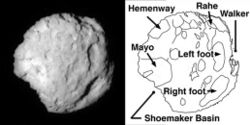Difference between revisions of "Comet"
m |
|||
| Line 3: | Line 3: | ||
A '''comet''' is a ball of frozen gases, ice, and dust, typically having a diameter of less than five kilometers. A comet develops a tail composed of its constituent materials, in gaseous or liquid form, when it is close enough to the sun for some of the frozen material to melt. Comet tails can be millions of kilometers in length and always "point" away from the sun due to the pressure of the [[solar wind]]. | A '''comet''' is a ball of frozen gases, ice, and dust, typically having a diameter of less than five kilometers. A comet develops a tail composed of its constituent materials, in gaseous or liquid form, when it is close enough to the sun for some of the frozen material to melt. Comet tails can be millions of kilometers in length and always "point" away from the sun due to the pressure of the [[solar wind]]. | ||
| − | The word "comet" first appears in Aristotle's ''Meteorology, | + | The word "comet" first appears in Aristotle's ''Meteorology,'' and derives from the Greek ''komē,'' hair.<ref>[http://classics.mit.edu/Aristotle/meteorology.1.i.html Meteorology, part 1], translation by E. W. Webster. See part 7: "The kind of comet varies according to the shape which the exhalation happens to take. If it is diffused equally on every side the star is said to be fringed, if it stretches out in one direction it is called bearded. We have seen that when a fiery principle of this kind moves we seem to have a shooting-star: similarly when it stands still we seem to have a star standing still." Aristotle believed comets could be formed ''from'' stars: "But when the exhalation is constituted by one of the fixed stars or the planets, owing to their motion, one of them becomes a comet. The fringe is not close to the stars themselves."</ref> |
Comet [[orbit]]s around the sun may be highly [[elliptical]], rather than nearly circular (such as planets), which takes them out past the orbit of [[Pluto]]. Some of the mass of the comet will [[sublimate]] with each pass by the sun and after many passes the comet may no longer be active and be simply an [[asteroid]]. | Comet [[orbit]]s around the sun may be highly [[elliptical]], rather than nearly circular (such as planets), which takes them out past the orbit of [[Pluto]]. Some of the mass of the comet will [[sublimate]] with each pass by the sun and after many passes the comet may no longer be active and be simply an [[asteroid]]. | ||
Revision as of 14:56, April 24, 2007
A comet is a ball of frozen gases, ice, and dust, typically having a diameter of less than five kilometers. A comet develops a tail composed of its constituent materials, in gaseous or liquid form, when it is close enough to the sun for some of the frozen material to melt. Comet tails can be millions of kilometers in length and always "point" away from the sun due to the pressure of the solar wind.
The word "comet" first appears in Aristotle's Meteorology, and derives from the Greek komē, hair.[1]
Comet orbits around the sun may be highly elliptical, rather than nearly circular (such as planets), which takes them out past the orbit of Pluto. Some of the mass of the comet will sublimate with each pass by the sun and after many passes the comet may no longer be active and be simply an asteroid.

Notes and references
- ↑ Meteorology, part 1, translation by E. W. Webster. See part 7: "The kind of comet varies according to the shape which the exhalation happens to take. If it is diffused equally on every side the star is said to be fringed, if it stretches out in one direction it is called bearded. We have seen that when a fiery principle of this kind moves we seem to have a shooting-star: similarly when it stands still we seem to have a star standing still." Aristotle believed comets could be formed from stars: "But when the exhalation is constituted by one of the fixed stars or the planets, owing to their motion, one of them becomes a comet. The fringe is not close to the stars themselves."

